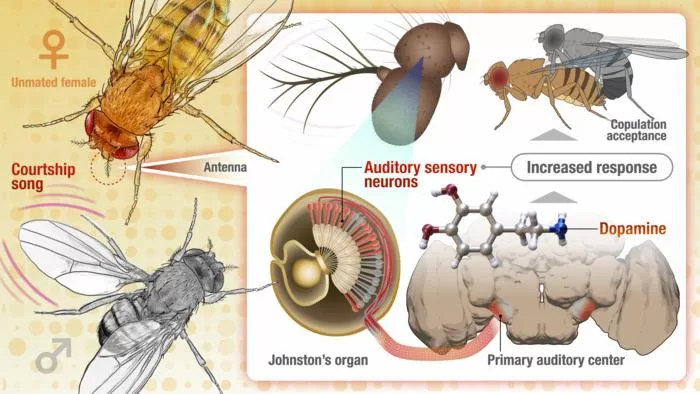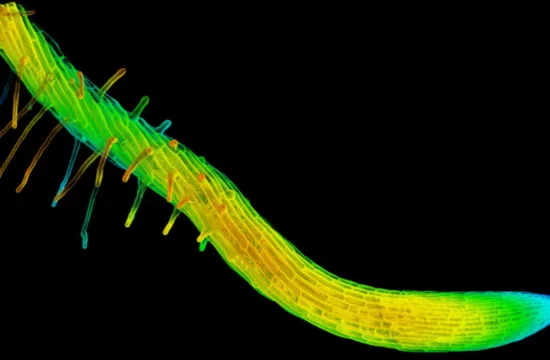|
Getting your Trinity Audio player ready...
|

Many animals, including humans, can flexibly modulate their responsiveness to sounds according to different situations. This ability allows them to optimize the use of their limited brain resources by prioritizing the processing of critical information at any given moment.
In line with this idea, a research team at Nagoya University in Japan has demonstrated that when female fruit fliesare eager to mate, dopaminergic signals can influence their sensitivity to sounds, including courtship sounds from males, which are an essential source of information for species reproduction.
“We believe that this finding is the first step toward understanding the neural mechanisms that underlie the universal property of flexible auditory response modulation in animals,” said lead author Azusa Kamikouchi, professor of the Graduate School of Science and the Institute of Transformative Bio-Molecules at Nagoya University. Their finding was published in the journal iScience.
Mating status is known to influence responses to courtship sounds in animals; however, the neural mechanisms underlying this status-dependent modulation have not been well understood.
Professor Kamikouchi, PhD student Haruna Yamakoshi, and their colleagues at Nagoya University conducted a study to clarify the neural mechanisms, using the fruit fly Drosophila melanogaster as a model organism. Drosophila is used extensively in neuroscience research due to its simple brain, many useful genetic tools, and short generation time.
Drosophila males produce courtship sounds by wing vibrations to attract females. Females listen to the sound to decide whether to accept the male’s courtship. It has been reported that female receptivity to mating is high when they have no mating experience and low when they do. Based on this report, the research group hypothesized that female responses to male courtship songs may be modulated depending on their mating experience.
To explore the validity of their hypothesis, researchers initially focused on neurons in Johnston’s organs (JOs) located in the second antennal segment of fruit flies, where they detect sound signals. They examined which neurotransmitter receptors are expressed in JO neurons, using a single-nucleus RNA-seq database.
The researchers found that three types of dopamine receptors are abundantly expressed in JO neurons. To verify whether dopamine signals affect the responsiveness of JO neurons, they suppressed the expression of dopamine receptors in Drosophila females and measured their neural responses to courtship sounds, using calcium imaging.
Results showed that neural responses to the sounds decreased in unmated females, whose mating drive is high. On the other hand, neural responses did not decrease in mated females and young females that had just emerged from their pupae, whose mating drive is low.
Researchers also observed behavioral responses to courtship sounds in unmated Drosophila females with suppressed dopamine receptor expression. They measured the time it took for the females to initiate mating, a key indicator of the increase in mating drive. As expected, the females with suppressed dopamine receptor expression reacted less to the courtship sounds, suggesting that these sounds were less effective in triggering their mating behavior under those conditions.
“We found that dopamine is one of the factors involved in flexible auditory modulation,” said Kamikouchi. “Previous studies have reported that the properties of the auditory system change depending on the situation in various animals, including humans, mice, and frogs. This study suggests that a common mechanism across species may underlie this type of auditory modulation.”
These findings are expected to provide a better understanding of the remarkably flexible sound information processing systems in animals.







